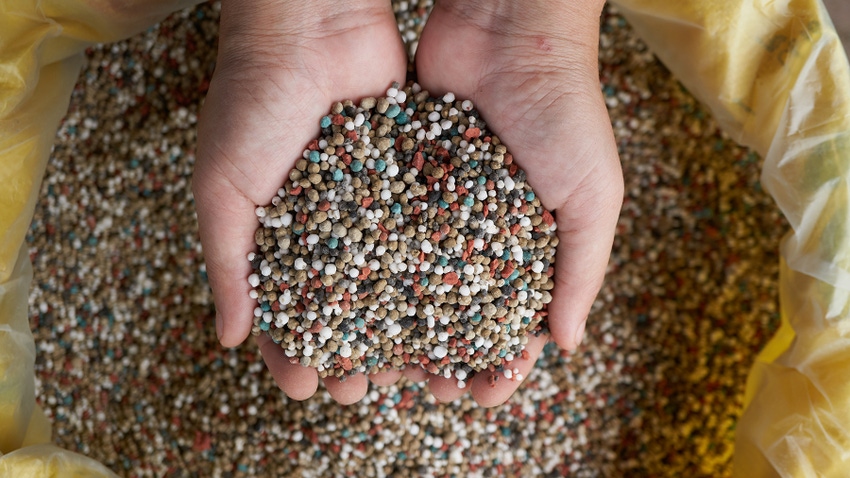March 19, 2024

While fertilizer costs are down from their summer 2022 highs, reducing fertilizer expenses, when possible, can be beneficial for Midsouth producers’ bottom lines.
“Depending on the crop, fertilizer expenses are one of the largest input costs,” said Trenton Roberts, University of Arkansas professor of soil fertility. “They can account for 20% to 35% of total inputs.”
Fertilizer costs have been dropping since 2022, but they remain significantly above the 10-year-average. Mississippi State University enterprise budgets in December had fertilizer estimates at $406.93 per acre for corn, $191.73 per acre for cotton and $82.30 per acre for soybean. This is well above the 10-year-average estimates of $213.71 per acre for corn, $99.78 for cotton and $47.13 for soybean. Several factors led to the increase in prices, beginning in 2021, said Brian Mills, MSU agricultural economist.
“Fertilizer prices started increasing in the middle of 2021,” Mills said. “We then had large increases in the early part of 2022 when Russia invaded Ukraine. Fertilizer prices peaked around the summer of 2022. Since then, they have been trending downward and are around where they were at the beginning of 2022.”
Producer concerns
Volatility within the market can cause concern for producers.
“We saw during COVID with the supply chain issues how volatile the fertilizer market can really be,” Roberts said. “Prices can really skyrocket if issues arise.”
MSU and University of Arkansas soil scientists say there are several practices producers can implement to reduce their fertilizer expenses. This is particularly important now as high input costs are creating thin profit margins.
One of the first steps producers can do is to take a soil test to determine the nutrients their soil lacks. Producers can take soil samples and submit them to their local extension office for analysis or they can have their crop consultants pull the samples for them.
“If you don’t have a reliable soil test, you are really just guessing at what your soil needs, and guessing can lead to disaster,” Roberts said.
Once they get their soil test results, producers can follow university recommendations to apply the appropriate amount of fertilizer for the crop they are producing. Mississippi State nutrient recommendations are available. Arkansas guidelines are available on their extension website. Nutrient management rates are included in crop-specific information.
Producers must determine their yield goals for the season and adjust their fertilizer applications to match their goals. Roberts said that can lead to producers making tradeoffs between fertilizer amounts and yield goals.
“Producers have to determine how they are going to arrive at their maximum profitability, and their most profitable scenario may not always be the highest yielding,” Roberts said. “Their maximum profitability may be with a lower yield, but they should be prepared for that lower yield. You can only get back out of the crop what you put into it, which is why nutrient inputs need to match yield goals.”
4 Rs of nutrient management
Producers can also use the 4 Rs of nutrient management to save on fertilizer costs and reduce unnecessary fertilizer applications. Those 4 Rs are the right rate, the right time, right place and the right source.
“Following the 4 Rs will help producers choose the right fertilizer to apply at the correct time in locations where it is needed,” said Vaughn Reed, MSU soil scientist. “For example, in Mississippi, we don’t recommend applying any nutrients in the fall because of leaching. Producers need to apply nutrients in the spring when the plant needs them the most.”
If producers try to cut costs by applying little or no nutrients, it can lead to problems including lower yields.
“I tell producers if your soil test tells you that you need a nutrient, you should put it out,” said Corey Bryant, MSU assistant professor. “You should also check your soil pH and apply lime if needed.”
The University of Arkansas has developed a Potash Rate Calculator to help producers more accurately determine their needs of that nutrient. Producers can put in their soil test results, their anticipated potash costs and the amount they plan to sell their crop for. The calculator will provide producers with the most economic potash application rate based on those factors. It is available online at https://agribusiness.uark.edu/decision-support-software.php. Roberts said while this decision tool was developed for Arkansas producers, others in the Midsouth may be able to use it if they use soil test method and procedure like the one used in Arkansas.
Producers may also want to take in-season crop tissue samples to determine if their crop has any nutrient deficiencies as the growing season progresses.
“Tissue sampling can help producers make in-season fertility adjustments, if they are needed,” Roberts said. "Tissue sampling can be an important way for producers to increase their profitability if the value of crops rises dramatically or if the fertilizer costs decrease significantly during the growing season.”
Read more about:
FertilizerAbout the Author(s)
You May Also Like




